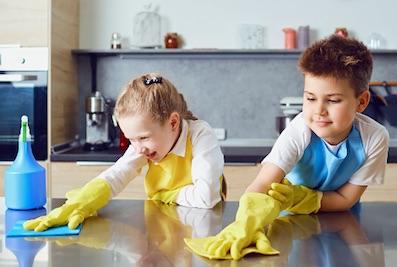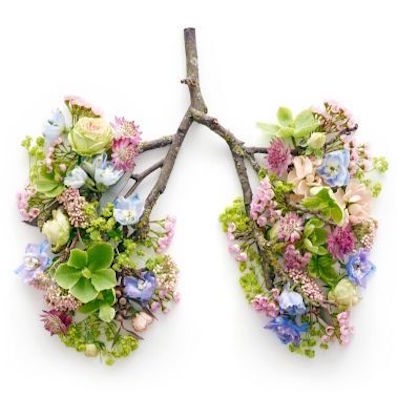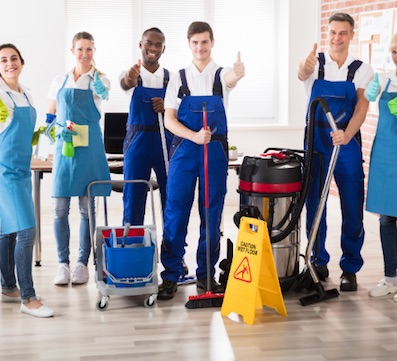 Cleanzine: your weekly cleaning and hygiene industry newsletter 3rd July 2025 Issue no. 1169
Cleanzine: your weekly cleaning and hygiene industry newsletter 3rd July 2025 Issue no. 1169
Your industry news - first
The original and best - for over 20 years!
We strongly recommend viewing Cleanzine full size in your web browser. Click our masthead above to visit our website version.
Using chemicals and indiscriminate biocides for cleaning? Are we on the right track?
 In this article, Joe Flanagan, LCIBSE, director of Essex-based Ingenious Probiotics, explains how probiotic cleaning works, and why, we as an industry, should consider its potential impact on the health and wellbeing of cleaning operatives as well as that of the occupants of the buildings we clean…
In this article, Joe Flanagan, LCIBSE, director of Essex-based Ingenious Probiotics, explains how probiotic cleaning works, and why, we as an industry, should consider its potential impact on the health and wellbeing of cleaning operatives as well as that of the occupants of the buildings we clean…
“The cleaning industry is now a subsection of the health and wellness sector. It's not about making rooms look clean for a price - the health of cleaning operatives and building occupants is paramount.
Prior to Covid-19, there were growing conversations within the cleaning industry about health implications linked to chemical cleaning products. In particular, mounting realisation that an industry dedicated to improving health and hygiene may be contributing to the reverse.
It is already established that long-term cleaning operatives using chemicals endure far higher cancer rates than the general population. In addition, cleaning chemicals are linked to breathing issues, child asthma and disturbed gut microbiome (the balance of microorganisms in our digestive tracts, which is important for good health). Furthermore, cleaning products in the USA are also linked with reproductive system health issues.
In response, we provided an easy way to implement change: Naturally sourced, probiotic cleaning products that improve hygiene results - without the negative health impacts of chemical biocides.
However, when Covid-19 hit, this positive change was sidelined for many in the industry. The need to replace lost business was pressing and urgent. And striving to sanitise every surface became an obsession borne out of understandable client fears.
But is this still the case?
In September and December 2020, the Lancet published articles that moved the focus for Covid transmission away from surfaces towards airborne droplets and aerosols (very small particles). (refs 1 & 2)
What does this mean for containment of infection in general?
Well, social distancing, proper hand washing and wearing a face covering - which reduces the projection of droplets into the air - all help. Also, reducing virus-laden aerosols in the air further helps (a lot!). Future building designs will no doubt address air purification - for both recirculated air and polluted outside air - and air flow patterns to help with this.
 But what about cleaning? What about sanitising surfaces?
But what about cleaning? What about sanitising surfaces?
The Lancet articles explain how Coronavirus found on surfaces was not viable. This seems to suggest that the chances of catching Coronavirus from a surface is unlikely. Other information sources repeat this.
Although fogging and sanitising had been considered very important, this is now under question.
The true human health cost of recent high intensity cleaning and sanitisation may not be known for some time.
The average adult breathes approx. 15kgs of air per day. And shockingly, 14% of UK Covid-19 deaths are linked to the poor quality of the air the victim breathed.
Given that we spend approximately 90% of our time indoors (work, home, car, shops etc.), doesn't it make sense to remove pollution from indoor air wherever we can? (3)
It is difficult or costly to remove some pollutants (e.g. flame retardant coatings) and easy, quick and inexpensive to remove others (e.g. cleaning products).
You can therefore reduce the amount of chemicals used when cleaning, immediately.
What about other side-effects of cleaning?
Pre-Covid-19, the biggest issue facing the World Health Organisation was antimicrobial resistance (AMR). AMR occurs when bacteria and viruses change over time and no longer respond to antibiotics and other medicines. This makes infections harder to treat and increases the risk of disease spread, severe illness and death.
Pre-Covid, the WHO believed AMR would claim 10 million lives every year by 2050. Unfortunately, AMR is likely to be far worse when Coronavirus is reduced as a threat.
This is because chemical cleaning and indiscriminate antibacterial cleaning agents create resistant strains of pathogens - often called ‘superbugs’. In fact, they are key culprits (along with overuse of antibiotics in humans and animals) in causing AMR.
Last Summer, a national newspaper reported that hand sanitisers also lead to an increase of dangerous pathogens on our hands. (4)
Anecdotal evidence shows cleaning chemicals causing costly damage to gym equipment (Europe and the UK), transportation equipment and delicate electronic hospital equipment (US).
 So how do we mitigate this, and quickly?
So how do we mitigate this, and quickly?
Well, probiotic cleaning products are shown to improve hygiene results, whilst reducing the issue of AMR.
As the products are naturally-sourced they are safe for both building occupants and cleaning operatives. Moreover, they positively benefit the wider environment.
The Lancet evidence suggests there is no need to exacerbate health issues by holding on to what was acceptable in the past. Just like passive smoking, a simple shift in understanding and habit can soon become the norm as health benefits become obvious. Passive smoking was once ‘ok’, but is now never acceptable (and doesn't that seem obvious now?).
Breathing in and absorbing chemicals and other biocides aimed at the indiscriminate destruction of all bacteria will (hopefully) become socially unacceptable soon. The question is, who leads this early adaption of improved health and hygiene and who waits until the last minute to change?
Changes in the built environment industry make the occupant's indoor air safety a responsibility of those caring for the building. (5). Industry associations are calling for 'safe havens' that achieve our right to breathe clean indoor air. How can chemical cleaners possibly fit into this goal?
Switching to cleaning with probiotics has been shown to dramatically reduce rates of Healthcare Acquired Infections (HCAIs).
The Lancet reports how 50% of in-hospital patients who died with Covid-19 also had secondary bacterial infections. These infections were contracted after admission to hospital, and include bacterial infection from ventilators. Some reports also point to infection from resistant strains of pathogenic bacteria. (7).
Reducing the rate of HCAIs would improve resources and reduce costs for the NHS, but this is a different issue.
If you are still reading, then you may be looking for an alternative to indiscriminate biocides and cleaning chemicals. One without the negative health impact.
So - how does probiotic cleaning work? (NB: this article refers only to our vegan and animal cruelty-free Provilan range, which uses non-chemical means to stabilise long shelf life).
The eco detergents/surfactants in Provilan products clean surfaces and break the outer membrane of envelope-type viruses (including Coronavirus) – as do all detergent cleaning products. But it's the added 'good' bacteria, called probiotics, that make the difference
These helpful probiotic microorganisms remain on surfaces and continue working for up to 72 hours after application. They consume organic waste/dirt and bio-allergens (dust mite faeces etc.). And they out-compete the 'bad' pathogenic / odorous bacteria (such as MRSA and E. coli) that can cause ill-health & odours.
The 'bad' bacteria simply die of starvation and they cannot develop a resistance to the lack of food.
In this way, the probiotics restore a healthy and balanced indoor environment microbiome, which is known to support better health and immunity.
 Traditional cleaning using indiscriminate biocidal techniques removes the crucial competition provided by the 'good' bacteria. This reduces recontamination times to less than one hour; i.e., surfaces cleaned once a day, every day, are likely to be pathogen-bacteria contaminated for 23 hours a day whilst still appearing visually clean.
Traditional cleaning using indiscriminate biocidal techniques removes the crucial competition provided by the 'good' bacteria. This reduces recontamination times to less than one hour; i.e., surfaces cleaned once a day, every day, are likely to be pathogen-bacteria contaminated for 23 hours a day whilst still appearing visually clean.
The Provilan probiotic ranges vary from floor and general surfacing cleaning, to animal wound cleaning and shampoo, hand soaps, medical tool cleaning, non-chemical hot tub maintenance and odour prevention.
All products use the same method of simply and mechanically out-competing bad bacteria and replacing with good. Probiotic sprays for hard-to-clean soft furnishings and difficult-to-reach areas perform the same function.
In summary, the cleaning industry is not just about making rooms look clean for a price - it is a subsection of the health and wellness sector. The health and wellbeing of cleaning operatives and building occupants is paramount.
So, keep cleaning the touch points etc. but switch to probiotic-enriched natural cleaning products. This:
* Improves hygiene at a microbial level compared with traditional chemical cleaning.
* Reduces antimicrobial resistance and helps protect our antibiotics.
* Reduces the risk of health damage to people (and our pets!).
* Protects client equipment from corrosion and damage - even with the extra cleaning frequency.
* Protects the wider environment from chemical pollution and benefits the circular economy (our probiotic range is actually used as part of waste water treatment).
* Reduces biofilms at microbial level
There is a higher focus on cleaning operatives. The wellbeing of those who trust us with their health via the safety and hygiene of their working and living environment rely on the advice and information we give to them.
This article is less about the science of how probiotic cleaning works, more about the health imperative to make a small, easy change for those supplying and/or using cleaning products.
To find out more about probiotic cleaning, visit the ‘About’ and ‘Knowledge’ sections of our website www.ingenious-probiotics.com
If you are not sure about change, then offer the option to your clients - give them the facts and let them decide.
A change is in the air (and now on the cleaned surfaces too!)
Contact us via the website, email [email protected] or call 01268 544530
References:
1 The Lancet
www.thelancet.com(20)30678-2/fulltext#coronavirus-linkback-header
2 The Lancet
www.thelancet.com(20)30514-2/fulltext
3 Science daily
www.sciencedaily.com
4 Daily Mail
www.dailymail.co.uk
www.twinfm.com
5 TM40
6 The Lancet
www.thelancet.com(20)30009-4/fulltext
7th January 2021







